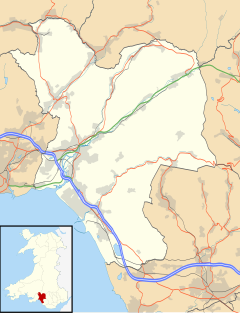Glynneath
Glynneath
|
|
|---|---|
 Glynneath Town Hall |
|
| Glynneath shown within Neath Port Talbot | |
| Population | 4,278 (2001) |
| OS grid reference | SN8706 |
| Community |
|
| Principal area | |
| Ceremonial county | |
| Country | Wales |
| Sovereign state | United Kingdom |
| Post town | NEATH |
| Postcode district | SA11 |
| Dialling code | 01639 |
| Police | South Wales |
| Fire | Mid and West Wales |
| Ambulance | Welsh |
| EU Parliament | Wales |
| UK Parliament | |
| Welsh Assembly | |
Glynneath (Welsh: Glyn-nedd), also spelt Glyn Neath, is a small town, community and electoral ward lying on the River Neath in the county borough of Neath Port Talbot, Wales. It was formerly in the historic county of Glamorgan. Glynneath ward covers only part of the community, with some 840 electors included in the neighbouring ward of Blaengwrach.
Industrialisation reached Glynneath when coal mining started in 1793, and rapidly expanded when the Neath Canal came to the village in 1775. Many features of the old canal still survive to the present time.
There are waterfalls to the north east at Pontneddfechan near the Brecon Beacons and large parts of the rural area are heavily forested.
Glynneath is home to the ruins of Aberpergwm House. Once owned by Rhys ap Siancyn, Aberpergwm House became the home of the Williams family, Welsh gentry with a strong tradition of using the Welsh language over English. Their descendants include the last of the Welsh household bards Dafydd Nicolas and folksong collector Maria Jane Williams. The Williams' family motto y ddioddefws y orfu (He who suffers, triumphs) was adopted by Glamorgan County Council. The mansion itself was remodelled in 1876 but is now derelict and little of note remains of the building.
St. Cadoc's Church, in the grounds of Aberpergwm House, was built as a chapel in the 17th century, rebuilt in 1808-1809 for the Aberpergwm Williams family and extended in 1836-41. It is a Grade II* listed building.
Rheola House, a Regency house designed c.1812 by the eminent architect John Nash, is also Grade II* listed.
...
Wikipedia

